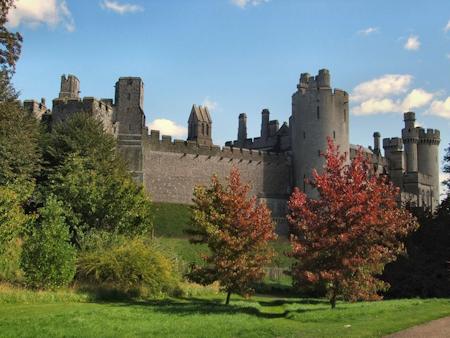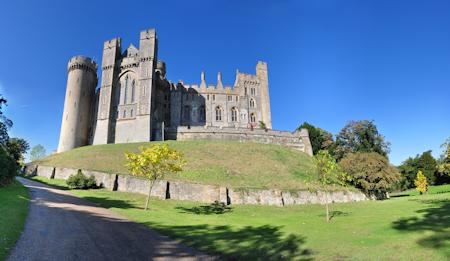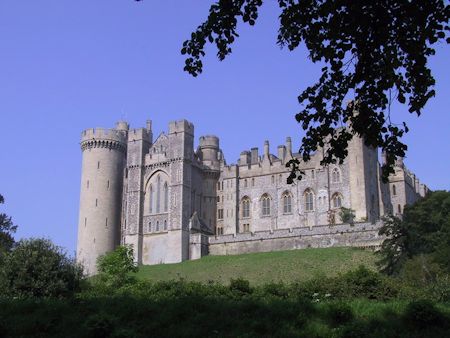
Arundel Castle
Arundel Castle is the very picture of a neo-Gothic fairytale castle, thanks largely to major restoration work in the 19th Century. The castle commands the area around the mouth of the River Arun and across the South Downs, and initially served as an important fortification against invasion from France.
The castle's origins date back to the Norman Conquest. Sussex was divided up into five Rapes (county areas) during the Norman period and the largest and most important was Arundel (it was later split into two still-sizeable Rapes). William the Conqueror's cousin and friend Roger de Montgomery was given the Arundel Rape amongst other large land grants and he started the construction of Arundel Castle in 1067.
Construction
Roger de Montgomery built the castle in a motte and double bailey layout which is a similar plan to Windsor Castle. The 100 foot high motte still dominates the centre of the site. Other remnants of the original castle include the lowest part of the inner gatehouse and an adjacent stretch of curtain wall, which both date back to around 1070.
The curtain walls are constructed from local flint and enclose the whole site. They were completed in phases during the 12th and 13th Centuries.
After Roger de Montgomery's death the castle reverted to the crown. After Henry I died his widow Adeliza of Louvain inherited the castle. She married Sir William d'Albini II who built the stone keep on top of the motte in 1138. Sir William was also granted the title Earl of Arundel in 1138. It is possibly the oldest existing earldom and the oldest extant title in the Peerage of England.
Royal Ownership
William d'Albini died in 1176 and the castle again went to the crown. Henry II spent a huge amount of money fortifying the castle and restructuring the buildings for domestic use. Henry II also added what is possibly the first royal garden in England. His son, Richard I, gave the castle back to the d'Albini family. The last male in the d'Albini line died in 1243 and the castle and its titles were passed over to the FitzAlan line via marriage.
The FitzAlan's enjoyed an unbroken line until 1580 and they made a number of improvements and alterations to the castle. Richard, 8th Earl of Arundel, added the well tower and remodelled the entrance to the keep in the early 14th Century.
The 11th Earl, Richard FitzAlan, posthumously built the Fitzalan Chapel in the western grounds of the castle. It is one very few church buildings that is divided in two. It has both a Catholic chapel and a Protestant parish church. Uniquely, a glass wall separates the two parts.
The chapel is superb example of gothic architecture with a carved timber roof and choir stalls. It is also famous for the artistry of the ancient tombs it contains and it is still the burial place of the Dukes of Norfolk.
Dukes of Norfolk
The FitzAlan line stopped when the daughter of the nineteenth earl married Thomas Howard, Duke of Norfolk. Since then the castle has been the seat of the Dukes of Norfolk, in an almost unbroken line.
The Duke of Norfolk is the premier dukedom of England. The dukedom comes with the hereditary office of Earl Marshal of England. As Earl Marshal the Duke is responsible for state ceremonial occasions such as the State Opening of Parliament and for the coronation and funeral of the sovereign.
Arundel Castle was badly damaged during the English Civil War in the early 1640s. It was besieged twice, first by Royalists and then by Cromwell's supporters. The castle was left roofless and unrepaired. It wasn't a favoured residence of the Dukes and they spent their time and money improving their other estates.
The first repairs to the castle were undertaken 1718 when the 8th Duke carried out some repairs. Subsequent Dukes carried out more extensive work. Notably, Charles Howard carried out extensive repairs and remodelling work starting 1787. Much of his work was revised by later Dukes, but you can still see his handiwork in the castle's library which is considered one of England's most important interiors from that period.
Charles Henry Howard created a new apartment block for Queen Victoria and her husband Prince Albert's visit in 1846. Almost every part of the castle that the Queen was likely to see was refurbished, remodelled and redecorated to Royal standards.
Later Dukes continued the castle's rebuilding with the addition of bright, colourful gardens, replacement windows to brighten the interior and much more restoration work.
Arundel Castle Today
Today the castle is still the home of the Duke and Duchess of Norfolk and their children. Many of the castle's rooms and galleries are open to the public. It contains an unrivalled collection of art, antiques, paintings and furniture in an outstanding setting.
The castle hosts numerous events throughout the year, including open-air theatre productions, medieval days and tournaments. Visitors are well catered for with both a cafe and restaurant complementing the on-site gift shop.
Arundel Castle has also been used as the set in a number of films and television programmes including the BBC's Antiques Roadshow, The Madness of King George and The Young Victoria.
Status: Museum / Event Venue / Theatre Venue
Owner: Arundel Castle Trustees Ltd
Tel: +44 (0)1903 882173
Email: visits@arundelcastle.org
Website: www.arundelcastle.org
Opening Times: April to November Tuesday to Sunday 10am to 5pm


Arundel Castle and gardens

Looking up at Arundel Castle

Arundel Castle viewed from the parkland below